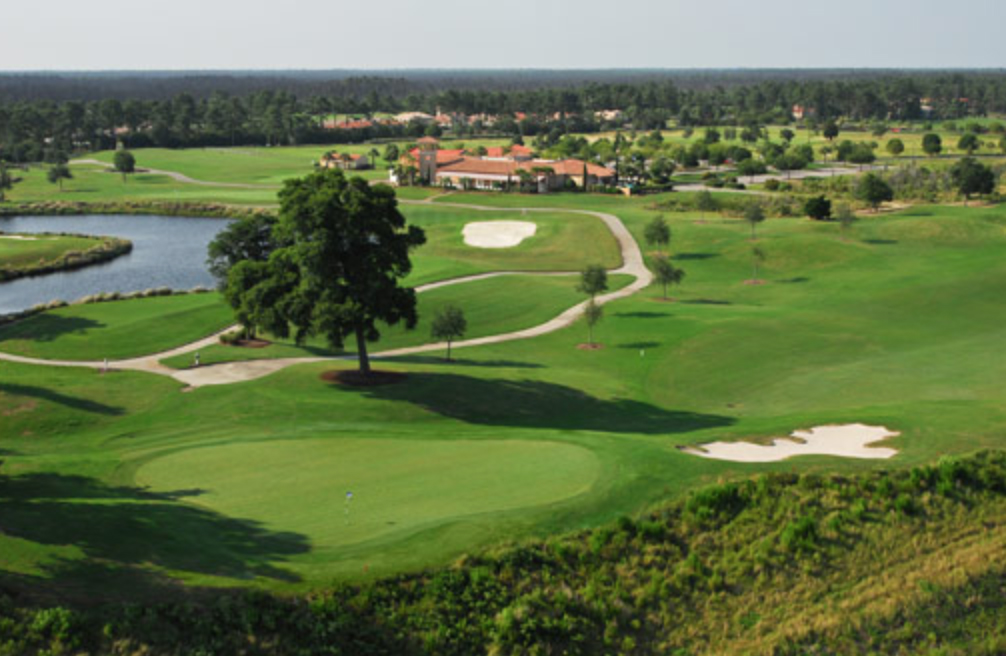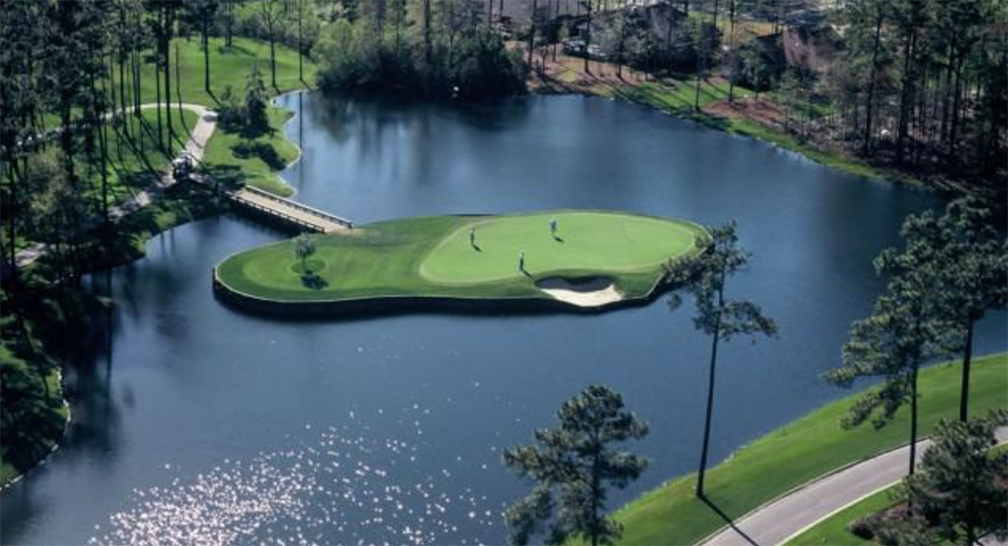
There are 90 golf courses listed on the roster of tracks on visitmyrtlebeach.com website, so there is no shortage of options for days and days of golf and fun on a visit to the Lowcountry where South Carolina and North Carolina meet on the shores of the Atlantic Ocean.
The roster is headed by those well-known for their bucket-list accolades – courses like The Dunes Golf & Beach Club, Caledonia Golf & Fish Club, True Blue Golf Club, and King’s North at Myrtle Beach National, all listed among the top 150 resort courses in the nation by Golfweek magazine.
But there are plenty of other courses that deserve your attention, either for their history, their setting or their combination of attributes and features. The three golf clubs listed below – Pine Lakes Country Club and Grande Dunes Golf Club in Myrtle Beach, and The Long Bay Club in Longs – are all fantastic in their own right and can enhance any trip to the Myrtle Beach area.

Long Bay Club
Pine Lakes Country Club set the bar high
There has to be a first for everything, and Pine Lakes Country Club is just that for the Myrtle Beach area. Robert White, a transplanted Scot, designed the course in 1927 as an amenity to the grand oceanfront hotel that had been built to lure tourists to the area.
White was the inaugural president of the PGA of America, as well as a co-founder of the American Society of Golf Course Architects, and eventually built the first White House putting green.
Pine Lakes Country Club was renovated in 2009, with the work carefully returning the course to White’s drawings other than two new holes (fourth and fifth) which replaced the original 17th and 18th holes. The putting surfaces were restored to their original largeness with only a few sweeping breaks and nothing too severe. The renovation also grassed every bit of the turf on the course with Sea Dwarf paspalum.
At just 6,675 yards and a par-70, Pine Lakes Country Club is one of those courses on which golfers shouldn’t lose many balls or need to hit lofted, spinning approaches into shallow elevated putting surfaces.
Pine Lakes Country Club was originally built upon natural dunes less than a half mile from the ocean and features numerous freshwater lakes and rolling fairways. Its routing manages to keep your attention – there are no tricks, no hidden hazards, and the layout provides a good opportunity to have a relaxing and enjoyable round. The fairways are tree-lined but not oppressive, and there are several ponds to capture sloppy play, but nothing too penal.
Perhaps the course’s best stretch are holes Nos. 14-17 – three par-4s of 438 yards or less and the 180-yard par-3 16th – which play through the pines and constitute a wonderful walk. The 438-yard 14th features a long, downhill drive toward a lake across the fairway then back up the hill to a protected green. No. 15, at 378 yards, gives golfers a good risk/reward opportunity to try and fly a huge sand bunker to save some distance on the dogleg-right challenge.
The routing is easily traversed by foot, as for the most part the terrain is very level. The holes feature generous avenues to slightly elevated greens that usually welcome a run-up approach. There is a bit of mounding around a few putting surfaces, but overall the look is natural and unforced – more on the minimalist side.
Pine Lakes Country Club qualifies as a repolished gem and led the way in establishing the area’s reputation as a golf mecca. Appropriately the Myrtle Beach Golf Hall of Fame sits outside just adjacent to the classic white clubhouse.
In an era when some feel that more is more, Pine Lakes Country Club is a testament to less can be more as well. The club’s moniker “the Granddaddy of the Grand Strand” certainly proves true.

Pine Lakes
Resort course at Grande Dunes one of area’s best
Elevation changes are not usually associated with courses in the Myrtle Beach area but the Resort course at Grande Dunes provides the exception to the norm. Routed along bluffs along the inland shore of the Intercoastal Waterway, the Resort course is fun, interesting, and demanding.
Stretching to a whopping 7,618 yards, the Resort course at Grande Dunes also features wide enough fairways to handle most any wayward shot – it could be considered a “bomber’s course” on which big hitters have a nice advantage. There are six sets of tees to mitigate the need for extreme length, making the course playable, but far from easy.
Seven of the holes at Grande Dunes are within sight of the intercostal, and 10 of the holes have doglegs. Golfers must contend with water on 14 holes, some of which have significant elevation changes. From the tee and fairway, every hole had some visual interest.
The ante is upped here by the fact that the course is at or near sea-level, buffeted by the constant wind and humidity that affects every shot.
After a relatively flat start, the Roger Rulewich design shines from fourth hole on. Enjoying the ups and downs of the terrain and a few boldly positioned bunkers, the challenge increases incrementally and gets far more interesting as the routing turns to the back nine.
On the stunning 244-yard par-3 14th and the 468-yard par-4 15th holes golfers can enjoy some breathtaking views of the intercostal. A few of the fairways on the home nine are a bit more restricted, with penalties in the offing for errant shots.
Other standouts are the par-4 12th, which measures at 449 yards from the back tees, is a dogleg right, and is narrowed on either side by mounding; and the 506-yard, par-5 fourth, which brings a large marsh/pond into play and is a fine risk/reward tester.
Grande Dunes’ Resort course has accumulated its share of honors over the years. Built in 2002, it was named a “Top 100” by Golf Digest in 2003, was the National Golf Course of the Year in 2009 and hosted the 2014 PGA Professional National Championship.
It’s a wonderful upscale golf facility complete with spacious practice facilities, an attractive clubhouse, and a well-conditioned course that’s one of the better options in the golf-rich Myrtle Beach/Grand Strand region.

Grande Dunes
Long Bay Club is one of Myrtle Beach area’s true ‘players’ courses
Players traveling to the Grand Strand and looking for a “real” challenge should arrange to play The Long Bay Club.
Located on the North Strand, The Long Bay Club was designed by Jack Nicklaus, who build a track that he could play and excel on – one with small, bunker-bordered greens, a routing that’s wide but generally favors golfers that can move the ball from left to right, and one that demands excellence on the approach.
Nicklaus used ample bunkering and fairway mounding at The Long Bay Club to create a course that is as visually appealing as it is challenging. It demands that players fly the ball to the green, which are small by today’s standards with few run-ups. Accuracy and distance off the tee are important to provide the best angle of approach, but a precise iron game is essential for success at Long Bay Club.
Water comes into play on eight holes and many of the putting surfaces are elevated and shallow. Many of the putting surfaces at The Long Bay Club are elevated; none are particularly large and tightly mown collection areas and deep bunkers surround most.
The par-4 10th is widely regarded as The Long Bay Club’s signature hole. Playing just 352 yards from the tips, the fairway is surrounded by a horseshoe shaped bunker. A drive into the sand makes the approach into an elevated green with steep slopes on all sides very difficult. Here, anything from birdie to double bogey or beyond is possible.
The most visually appealing of The Long Bay Club’s par-3s is the island green 13th hole. Playing just 156 yards, the hole’s difficulty is defined by the wind and the ability of players to deal with the surrounding water.
The par-5s at The Long Bay Club offer golfers a chance to pick up strokes, but they must be earned. No. 15 is the easiest of the three-shotters, playing just 492 yards from the tips with a stream dissecting the fairway and running up the right side. The putting surface is protected by sand on the left and water on the right, but smart players could reasonably expect to have a birdie putt.
The 17th hole is the course’s most difficult one-shotter, measuring 203 yards from the tips. A green shaped like an inverted L is surrounded by eight bunkers and a steep collection area on the right.
What’s the key to success at The Long Bay Club? Make sure you have enough club in your hand. If there is a bunker in front of the green, make sure you clear it because there is room in the back. It’s also important for golfers to adjust their game for the conditions – if they hit a 7-iron 150 yards at their home course, they are likely only going to carry 140 yards at sea level.
Another tip: tee it forward or choose another course if you are not a golfer who can hit all the shots. The Long Bay Club is a “player’s course” requiring a high trajectory into your target. But if you are reasonably good, it is well worth visiting, and is plenty of fun.
The Long Bay Club doesn’t have some of the coastal scenery that many have come to associate with Myrtle Beach golf, but it’s one of the area’s most challenging and highly regarded courses. From the first tee to the final putt, The Long Bay Club is an outstanding test of golf, giving Grand Strand golfers the kind of challenge and quality they appreciate.
A player that scores well on the 7,025-yard, par-72 layout will leave the course with a sense of well-deserved satisfaction. Those who don’t play to their handicap typically come back, hoping to exact a little revenge on a track that remains an area favorite.

Long Bay Club

